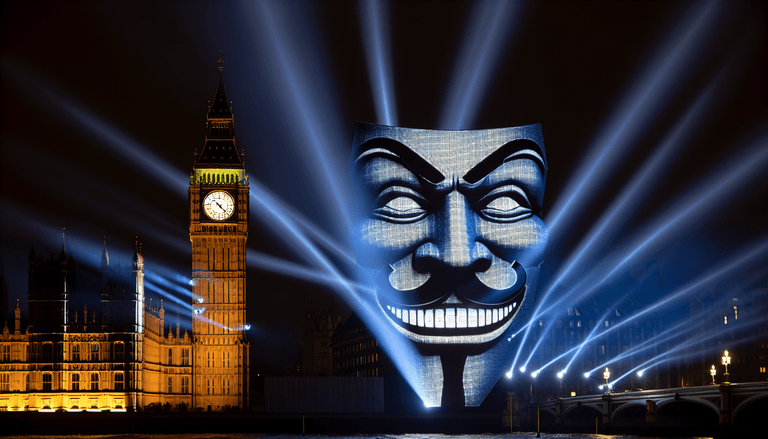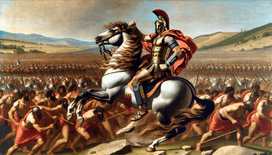Ah, the infamous Gunpowder Plot of 1605. A time when politics was a powder keg, literally, and Guy Fawkes became the household name for anyone who ever considered bringing the proverbial house down. But what if I told you that Guy Fawkes and his band of merry plotters had access to that bubbling cauldron of opinion, gossip, and occasional cat videos: social media?
The Gunpowder Plot Goes Viral
Picture this: it's the 5th of November, and while London sleeps, a group of conspirators gather 'round their smartphones in an underground chamber, slyly sliding into history-in-the-making WhatsApp group chats. Their plan? Not just to blow up the Houses of Parliament, but also to go viral doing it. After all, if a conspiracy tree falls in the woods and nobody live-tweets it, did it even happen?
Imagine Guy Fawkes as the social media manager for the operation, tweeting under the handle @FawkesTheBlazer. His timeline is filled with cryptic messages like, "Tonight's forecast: dark with a slight chance of fireworks" or "Feeling lit tonight! #GuyFawkes". His followers, a mix of political radicals and fireworks enthusiasts, can't quite tell if he's hinting at grand larceny or just another night out in London. "Blaze of Glory" is the playlist of choice on Spotify, naturally.
TikTok: Lighting the Fuse
The real game-changer? TikTok, where the plotters post videos demonstrating how they tested various gunpowder recipes. Forget cooking shows and dance challenges, this is the real explosive content. In a particularly popular clip, we see Guy tinkering with explosive concoctions, promising in whispers, "For every like, we add another barrel." As for the theme song? "Fireworks" by Katy Perry would probably be too on-the-nose, but you can bet Monty Python’s "Always Look on the Bright Side of Life" would be highly ironic.
Facebook: Revealing the Plot, One Meme at a Time
If you think FB stood for Facebook, think again, it’s FawkesBook in this universe. Guy expertly uses memes and gifs to rally his supporters, pulling in those radical new followers with punchlines about powerful parliaments needing a "quick redecorating". Sir Robert Catesby, the brains behind the plot, might even pen a heartfelt Medium post exploring the philosophical justifications behind the plan, title: "Blowing Up the Establishment: A Necessary Evil or Just Good Fun?"
The Plot's Downfall: Connectivity or Lack Thereof?
History tells us the Gunpowder Plot was thwarted due to leaked information, something one might suggest the conspirators had under-estimated. But with social media? Ah, enter the ultimate downfall: over-sharing. Turns out, maintaining an effective conspiracy is nigh impossible when your follower count matters more than your follower vetting. One wrong "like" on an incriminating photo and boom, plot foiled faster than you can say "Oops!"
Lord Monteagle, a savvy politician of the day, stumbles upon an anonymous DM tip-off about suspicious activity in the comments section of @FawkesTheBlazer’s account. Screenshots are taken and sent via the rapidly-growing concern of "KingService", an Elizabethan WhatsApp group chat. The rest, as they say, is history. The authorities raid the cellars, finding Guy poised, looking guilty as a cat caught up the curtains, and prevent a literal blow-up of epic proportions.
What If the Powder Did Go Boom?
Let us muse, for a moment, on what might have happened had the conspirators truly harnessed social media to their advantage. Perhaps they'd deploy a distraction campaign on Instagram, flooding the platform with irresistible, yet baffling, delish pics of 17th-century culinary confections. "Go on, smash that like as we smash expectations!" they'd entreat from behind artfully arranged displays of marzipan and peacock pie.
Or, even better, maybe they could have devised the world's first live stream bombastic event, billed as "An Explosive Evening With the Lords". The royal reaction would go live on #ParliamentPyrotechnics, a hashtag trending faster than a powdered wig in the wind. The possible historical ramifications are mind-bending, to say the least.
Conclusion: Lessons from a Virtual Plot
Whilst social media might have offered Fawkes and his friends a dazzling new way to coordinate and publicise their explosive intentions, it's a cautionary tale in connectivity. Such are the double-edged swords of our digital age, tools that can build revolutions and yet, in an ironic turn, are equally adept at dismantling them.
So remember, dear reader, the moral of this story is not about learning how to plot a 17th-century coup from your smartphone; it's about understanding that with every tweet, every post, and every viral TikTok lies the potential for the past to provide us with a rather explosive lesson in modern technology's mighty reach.







